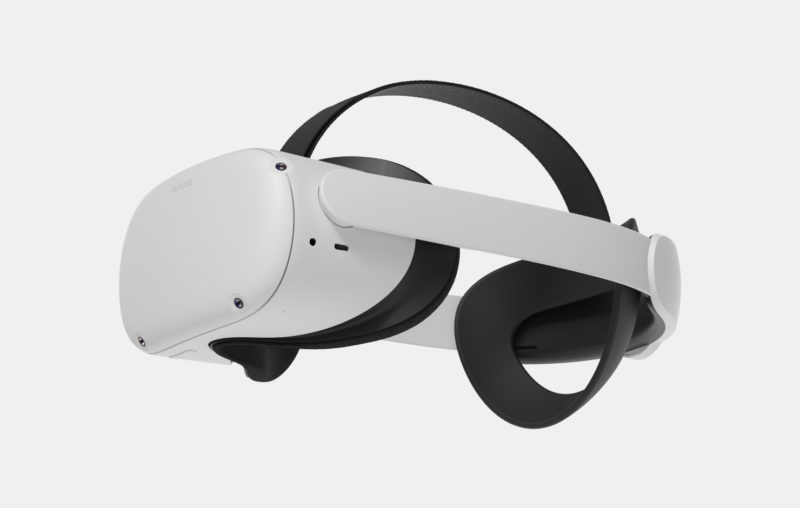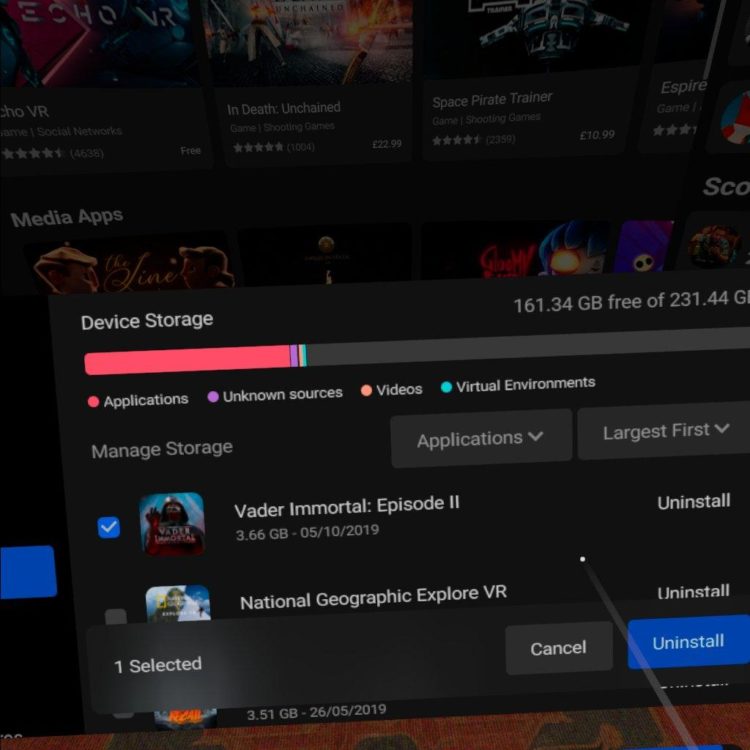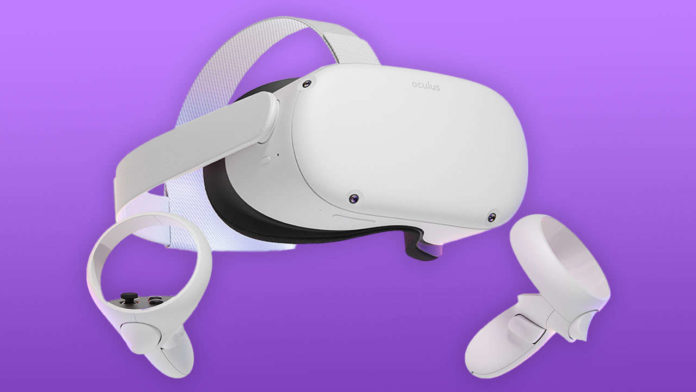The Quest 2 has launched to a ‘mostly’ rapturous fanfare of positivity. Critics of Facebook’s login requirements and OLED black lovers aside, the general view is that it’s faster, lighter, more comfortable, and all-around better than its predecessor.
At $299 it’s also remarkably affordable. But there is a caveat. Go to virtually any VR related website or Reddit posts and you’ll be told that 256 GB of storage is super necessary and that the elite strap is also an essential upgrade. Of course, if you’re buying a Quest for fitness, then a protective, wipeable replacement faux leather or silicon cover is also a must buy.

So your $299, becomes $399, then $448, then $477. Many will also want the $89 official link cable for PC connectivity. Costs are mounting but that’s not all, the Quest does not come with a single included game, so you also have to factor in software too.
So your $299 investment is now over $600 and climbing fast. Should you panic? Should you abandon the idea of buying the Quest 2 at all thanks to the spiraling ancillary costs caused by the Diderot effect?
Not so fast. Quest 2 IS a fantastic headset, at a great price. But, as I’ve shown above, there are some additional costs to factor in. Some of these might be vital to you, some might not be needed for your usage case. In this article I want to help new VR users especially, those who are considering a Quest 2 for Christmas, determine what extra accessories they really need, and how much they should be spending.
Related: VR Cover Accessories for Quest 2 – Everything you Need
The Quest 2 has no expandable memory slots, meaning what headset you choose is what you are stuck with. As the storage decision is also the only purchase that cannot be put off until later we will focus most of all on this question. Rather than give my subjective opinion, what I want to do is actually SHOW you how much storage you’ll need, by looking at the size of current games, and timing the uninstallation and reinstallation process, so you can see for yourself what you need.
Useful? I think so. Let’s begin!
My starting assumptions about you, the reader
Before I talk about Quest storage, I want to specify my target audience here. This is an article intended largely for the VR newcomer, or at least a newcomer to standalone VR who hasn’t used a Quest 1 and therefore has no prior experience of usage to draw upon. I am also assuming that you have a moderate to low budget and that you would rather avoid paying out for things you don’t need. So if you’re a VR veteran and know what you want, or you’re financially loaded and don’t see the extra $100 outlay as significant then by all means buy whichever version you want, preferably the larger so you never have to worry about storage concerns.
The other assumption I’ll make here, is that your reason for purchasing a Quest 2, is at least partly motivated by a desire to use the headset for fitness and exercise. We are VR Fitness Insider after all. Therefore I’m going to focus on the game sizes and prices for the major fitness games primarily.
My Prior Quest 1 Experience, using the 128GB Quest.
I have been using the original Quest headset since the launch of Quest 1, on 21st May 2019. I purchased the 128 GB as I felt the 64GB would be insufficient for my usage. I intended to use my Quest for standalone fitness games and high definition movie watching primarily. As a game reviewer, I have access to a lot of free titles and wanted to ensure I had space to try them all. What follows is my actual experience of owning Quest 1.
Movies & Media – Actual storage requirement 0 GBs, as I could stream directly from my PC.
I quickly found out that storing movies on the Quest wasn’t necessary, thanks in large part to Virtual Desktop, an app on the Quest store that wirelessly connects your Quest to your PC. I found that I could stream all my movies from anywhere in my house with no latency issues or stutter at all. The Quest’s Netflix and Amazon Prime apps also worked flawlessly. Therefore what I thought might be my biggest storage need was an illusion, I simply didn’t need media storage at all. If you have a PC and a reasonable router then you won’t need to store any media on your Quest itself. Just buy Virtual Desktop and stream it.
Of course, if you plan to take your Quest out of the house, or to locations without internet access and you want to watch a bunch of movies or media content there, then you’ll need to load it on to the Quest itself, but it’s pretty easy to drag and drop these files onto it like a USB stick so there’s no need for any permanent media storage capability on the Quest for most people.
Game storage experience – I’ve purchased 48 games and apps that totaled 64GB of content over the past 18 months. This doesn’t include the size of the Quest OS itself, and any preinstalled apps, or other free content I’ve installed, which adds up to 69 GB in total.
Below I’ve recorded every single app I’ve purchased on the Quest platform so far, the game’s cost, in British pounds as I’m from the UK, and its installation size. This should give you a pretty good idea of how many games you’d need to buy and install to fill 64GB, and how much it would likely cost.
If you’re interested in just VR Fitness Games. Check out the Best Oculus Quest 2 VR Fitness Games for Exercise and Workouts.
My purchased apps
AFFECTED: The Manor £7.99 1.25 GB
Apex Construct £14.99 1.34 GB
Apollo 11 £7.99 1.78 GB
Audica £22.99 914 MB
Audioshield £14.99 569.7MB
Bait £2.99 212.7 MB
Beat Saber £22.99 588.5 MB (optional DLC’s will increase file size)
Creed: Rise to Glory £22.99 995.4 MB
Down The Rabbit Hole £14.99 1.24 GB
Dreadhalls £7.99 519.3 MB
Eleven Table Tennis £14.99 716.7 MB
FitXR £22.99 1.28 GB (optional DLC’s will increase file size)
Five Nights At Freddy’s £22.99 2.25 GB
Fujii £10.99 425.1 MB
Holopoint £10.99 259.9 MB
I Expect You To Die £18.99 897.8 MB
Ironlights £14.99 837.3 MB
Journey of the Gods £22.99 970 MB
Knockout League £14.99 1.02 GB
Lies Beneath £22.99 1.74 GB
Moss £22.99 2.64 GB
National Geographic £7.99 3.55 GB
Ninja Legends £14.99 1.17 GB
Ocean Rift £7.99 845.9 MB
OhShape £14.99 316.6 MB
Path of the Warrior £14.99 1.68 GB
Pistol Whip £19.99 1.3 GB
Racoon Lagoon £10.99 1.63 GB
Racket: NX £14.99 613 MB
Real VR Fishing £14.99 771.2 MB
Robo Recall Unplugged £22.99 3.47 GB
Rush £14.99 963.6 MB
Shadow Point £14.99 2.16 GB
Sports Scramble £22.99 1.16 GB
Synth Riders £18.99 773.2 MB (optional DLC’s will increase file size)
The Climb £22.99 1.64 GB
The Curious Case of the Stolen Pets £10.99 815.9 MB
The Room VR £22.99 2.32 GB
The Thrill of the Fight £7.99 1.12 GB
Titans of Space £7.99 1.12 GB
Until You Fall £18.99 1 GB
Vadar Immortal 1 £7.99 2.67 GB
Vadar Immortal 2 £7.99 3.61 GB
Vadar Immortal 3 £7.99 3.75 GB
Virtual Desktop £14.99 419 MB
VZFit Explorer (annual sub) 267 MB
VZFit Play (annual sub) 1.7 GB
Wander £7.99 363 MB
Total spend £697.54
Total storage size 63.63 GB
By a funny coincidence then I have purchased exactly 64 GB worth of games in the 18 months from the launch of Quest 1 to the release of Quest 2. At full price that’s nearly £700 worth of software or around a thousand dollars!
Now, it’s important to note that the Quest operating system and preinstalled software also takes up space, so that your actual free storage will likely start at around 50 GB. This means that had I bought the 64GB Quest 1, I would have, at some stage needed to uninstall some games, probably around 15GB worth. The question is would this have mattered to me?
I have to answer personally, with a resounding no. I regularly play maybe 6 or 7 games, and fully half of my library has never been loaded up more than once or twice and I could have uninstalled them without missing them at all. In short, I now wish I’d bought the smaller Quest 1 model and saved myself the £100.

What happens when you run out of space?
In this section, I want to explore what actually happens if you do run out of space. Is it an unmitigated disaster that will render your Quest 2 useless, or is the concern overblown, and not really that big of a deal?
You won’t lose the game by uninstalling it, but you might lose some saved game data.
Firstly you should know that once you have purchased (or even installed a free title) then it remains in your library forever. This means that even if you buy a Quest 3 in a couple of years’ time, once you’ve registered it your Facebook account you will see every single purchase you’ve ever made on the Quest platform, with the option to install next to it. Clicking the install option will install the game to your headset, but depending on whether the game has cloud saves enabled, you might lose all your previously saved data. Remember though that this also happens if you upgrade from Quest 1 to Quest 2 though, so this potential loss of saving game data is unavoidable for all.
Reinstallation is not a big deal with fast internet and no data limit but might be with slower bandwidth or a data cap.
If you have really fast internet, then reinstalling games isn’t much different from drag and dropping on to a USB stick, but will be more tedious if your internet is slow. If you have a monthly internet data limit then 256GB is probably the better option.
In the video below I’ve recorded myself uninstalling, then reinstalling Crytek’s ‘The Climb‘, at just under 2 GB, a larger than average current title, but possibly more in keeping with the typical size of future titles on Quest 2. As there is nothing less interesting than watching me wait for a game install the video serves a double purpose as I cycle through all the virtual environments so you can see just how quickly the Quest 2 loads up. It’s also showing off the 90hz so tracking latency is improved over the Quest 1.
Additional Factors to Consider
Will future Quest 2 games be bigger?
To an extent, this is likely to be true. Saints and Sinners is the largest Quest game currently, weighing in at 8 GB, with a rumored ‘Horde Mode’ expansion coming that will make it nearly 12GB. If all future Quest 2 games were this size then 64GB would be far too small, but in all honesty, this is highly unlikely. Saints and Sinners is a top-end PC title and by far the most ambitious PC to Quest port to date. Unfortunately, there are no confirmed plans to bring any other major PC titles to Quest, and as you can see from my game library above, the vast majority of games require 1 to 2 GB only. There are some big game licenses like Assassin’s Creed and Splinter Cell coming to Quest next year, but these will almost certainly be ‘experiences’ rather than full-sized games, think Vadar Immortal, Batman Arkham, or Bethesda’s Wolfenstein VR, with typically an hour or two of content, that could then be uninstalled if required.
EDIT 10/11/20202 bigger games might be coming!
Ironically, less than an hour after I posted this, AAA developer giant Respawn has announced that their upcoming PC mega title Medal of Honor will get a Quest release! This is great news for Quest fans, and will likely be a larger filesize comparable to Saints and Sinners. With this announcement, it’s also reasonable to speculate that other anticipated PC titles that have currently been delayed, like Lone Echo 2 and After the Fall, might be delayed due to developers agreeing with Oculus to create Quest ports of those games too.
The question is does this change things? If you’re only going to use the Quest as a mobile headset, and you don’t want to uninstall these games after completion, then I’d say yes. These games will likely be 7 or 8 GB in size each potentially.
However, if you own a PC then I’d say absolutely not. These top PCVR titles will always be considerably better utilizing dedicated PCVR hardware than even the Quest 2’s mobile chip, so if you own a PC you won’t be installing the games on the Quest itself anyway, which leads me on to the next point below…
A PC is a better investment than extra mobile storage
Another point that should be stressed is that games such as Saints and Sinners play much better on PCVR, so if you want the full experience you’d be installing it on your PC rather than the Quest anyway. If you don’t have a PC, I’d strongly recommend investing your extra money into a PC rather than mobile headset storage. Nothing will boost your VR experience more than being able to connect your Quest 2 to a desktop PC, either through a link cable or wirelessly via Virtual Desktop.
256 GB won’t future proof your headset
Buying the 256GB version to future proof the headset is an argument I hear a lot on forums. It makes sense on the surface, but you should know that Oculus has released 5 headsets in the past 4 years, and 4 of those are now discontinued. VR is a fast-evolving technology and the Quest 2 will be superseded by a new model probably within the next 24 months, so keep that in mind. Like a dog, a Quest is not just for Christmas, but it probably won’t last longer than two Christmases.
Summary – Unless you’re a hardcore Questor you can probably live with 64GB, providing your internet is a reasonable speed.
Hopefully, my experience with Quest 1 above, alleviates the concerns of many of you who want to try VR for the first time, or maybe plan on buying a headset or two for your kids.
As long as you’re happy to uninstall some games once you’ve finished with them and treat the headset in the same way as you’d treat a USB stick then you’ll be fine with 64 GB. Most games can be uninstalled and reinstalled in minutes, and the headset will likely be replaced with a new model in a couple of years anyway.
If you have a PC, (which I highly recommend) then you’ll be installing most of your games on the PC’s hard drive anyway, so the large file sizes of games like Saints and Sinners are irrelevant.
The 256 GB version is really for heavy Quest 2 users, those who want to store multiple media files on the headset for whatever reason, and maybe for those who record a lot of footage from the headset. I myself did buy the 256 GB version with video recording in mind. As I record for this site, it would be annoying if I ran out of space midway through a recording session so the extra space gives me that peace of mind. I also get a lot of games for free for review, that I wouldn’t otherwise be purchasing, and I need space for those.
If I didn’t have those specific requirements I would have just bought the 64GB version.
Hopefully, this helps some of you decide which version is right for you. Feel free to post your own opinions in the comments, and if you have any further questions I’m happy to answer.











